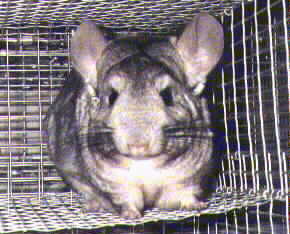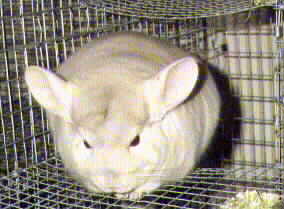Chinchillas
This is Graycee a standard grey chinchilla
Chinchillas, (Chinchilla laniger), Chinchillas have become popular
as pets although originally they were wild animals in the Andes Mountains
in South America. Chinchillas are in the Order Rodentia that is shared with
animals ranging from prairie dogs to capybara to mice.
When the early Spanish explorers returned to Spain from South America they
brought with them, Chinchilla pelts. They soon became the rage in Europe
taking over 100 skins to produce a single coat, much to the dismay of the
wild chinchilla population. When trapping became less profitible, people
began trying to breed them. Over the years, spectacular colors have been
developed by breeders.
Their luxurious fur is so soft and pleasant to the touch that at one time,
they were unrivaled in the fur industry for fashionable fur coats. That
demand meant that the chinchillas were nearly exterminated in the wild by
trappers and attempts at raising them in captivity for the fur-trade did
not become successful until the 1920's-40's. At one time there were thousands
of chinchilla 'ranches' around the country but now that number has dropped
in recent years. Ranchers have developed many lovely colors by breeding
and inbreeding. Although the original wild chinchilla was a light to dark
gray in color with lighter undersides, they have been bred to produce various
shades of gray, silver, velvet black, white, beige, brown and brown velvet.
The chinchilla is from 10 to 14 inches long, with a tail 6-8 inches. They
weigh about one pound or a little more. Their hind limbs are longer than
their front limbs which give them great jumping power.
Females and males become sexually mature at 5-9 months of age. Mating usually
takes place in late fall. Gestation is 111 days and litter sizes are from
1 to 6 but average 3 or 4. The young nurse from 6 - 8 weeks. A female can
have up to three litters per year. Chinchillas can live up to 20 years in
captivity.
Chinchillas should be housed in a wire mesh cage, with openings not more
than 1/2" x 1". A cage for a single chinchilla should be 3-4 cubic feet.
The floor and shelves provided for resting and can be made of 1/2 inch mesh
wire. Larger openings in mesh can promote broken legs that get caught when
jumping. If Breeder cages can be made in rows, with openings in the back
connecting to a wire tunnel which is used by a male to enter the cage of
any female in that strip. Each female wears a flat metal collar, bigger
than the opening to prevent her from entering the tunnel. Chinchillas are
voracious gnawers, so there must be no wood as part of the cage construction.
A metal pan underneath can catch the droppings and urine. Shavings in the
pan will help to absorb wet material.
This is Miss Skeeter, a beige chinchilla.
Provide high quality hay cubes and pumice stone for gnawing and to keep
teeth properly worn.
Chinchillas need a quiet environment, out of a draft or direct sunlight,
although they do need good light. Chinchillas like a nest box to sleep in
and have their babies. Climbing branches must be of a species that is not
toxic because they WILL chew on them. They prefer a temperature of 65-70
degrees F so if you are a warmblooded type, you might prefer a reptile.
Chinchillas are active a dusk and dawn and do not like direct, bright light
or loud noises but they do need about 12 hours of light per 24 hour period.
Chinchillas must have a pan of special 'dusting material' (volcanic ash
prepared for chinchillas) placed in their enclosure almost daily. If you
do not, the coat will become oily and lose its softness. This will cause
quite a bit of mess in the area around the cage. Placing the pan containing
the dust for 30 minutes a day will be sufficient. The dust can be placed
in a large jar or fish bowl or heavy metal pan. Their teeth must be monitored
as in all rodents. If you put fresh branches in the cage regularly, you
will probably never have problems. Males can get hair rings around their
penis and prevent them from retracting it. These have to be removed by hand
with forceps or tweezers.
An automatic watering system or rabbit bottle on the outside of the cage
both work well for water.
This is Little Foot, a black velvet chinchilla.
In the wild they eat grass, bark, fruits, cactus, some roots and some leaves.
In captivity, their diet consists of chinchilla pellets and hay. Rabbit
pellets are not the same as chinchilla pellets and can cause health problems
in chinchillas if fed as a steady diet. Chinchillas need about 20% protein,
3% fat and 15% fiber. Vitamins may be added to the pellets or water. Small
amounts of apples, nuts and raisins and even dried rose hips are good treats
but must be fed in very small quantities. A small amount of Purina Lagomorph
Diet ( may be added for variety. The breeder listed at the end of this section
suggests the following diet:
2 tbl. chinchilla pellets twice a day.
Treats consist of a whole grain supplement and one raisin or slice of apple.
Never give more food than suggested unless it is a pregnant or lactating
female.
If you would have to raise orphaned babies, you must keep the temperature
around 70-75 degrees F. Their eyes are open from birth, but they are very
small, fully furred. You can foster them to a lactating guinea pig or make
a formula of evaporated milk and water 1:1 with vitamins. Add baby rice
cereal at 1 week of age.
If you plan on breeding Chinchillas, you should probably buy a book that
deals specifically with this subject. There are lethal gene combinations
when it comes to breeding certain colors to the same color, like white to
white, black velvet or brown velvet to its own color. But you could breed
any of these to any other color including one of these three except its
own color.
Chinchillas can make wonderful pets for OLDER children and adults. They
make a variety of sounds and body language that conveys their current moods
so you know when they do not wish to be bothered. Younger children may not
be able to discern these moods as well as older people.
R-Zu-2-U Home
R-Zu-2-U FAQs
R-Zu-2-U Animal "Terms"
Treasure Ranch Home



